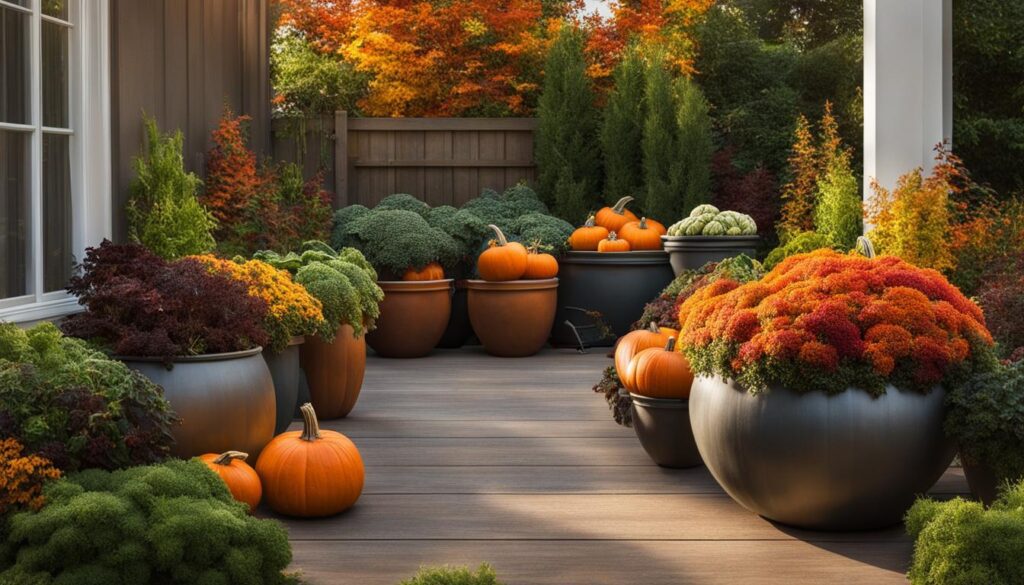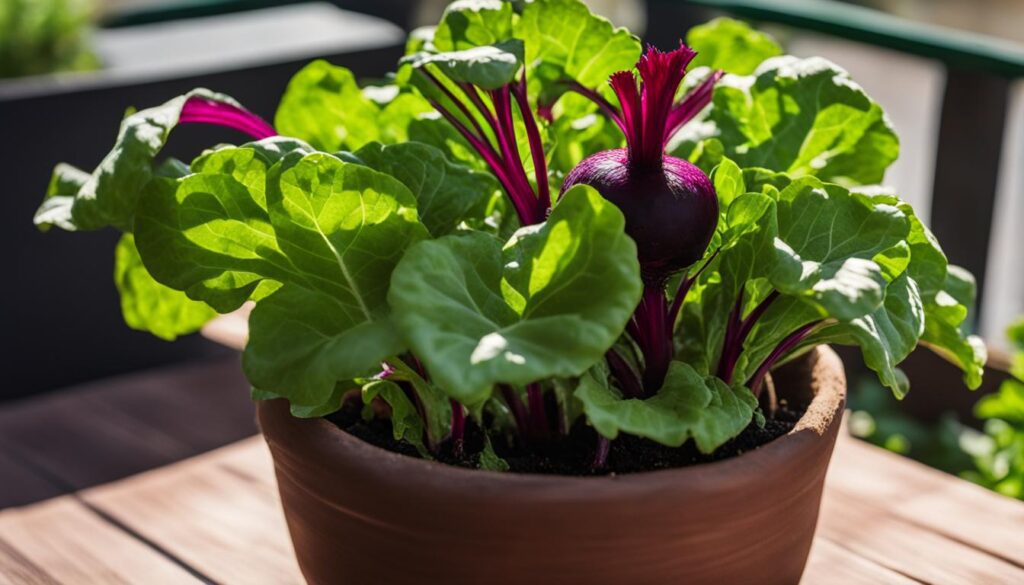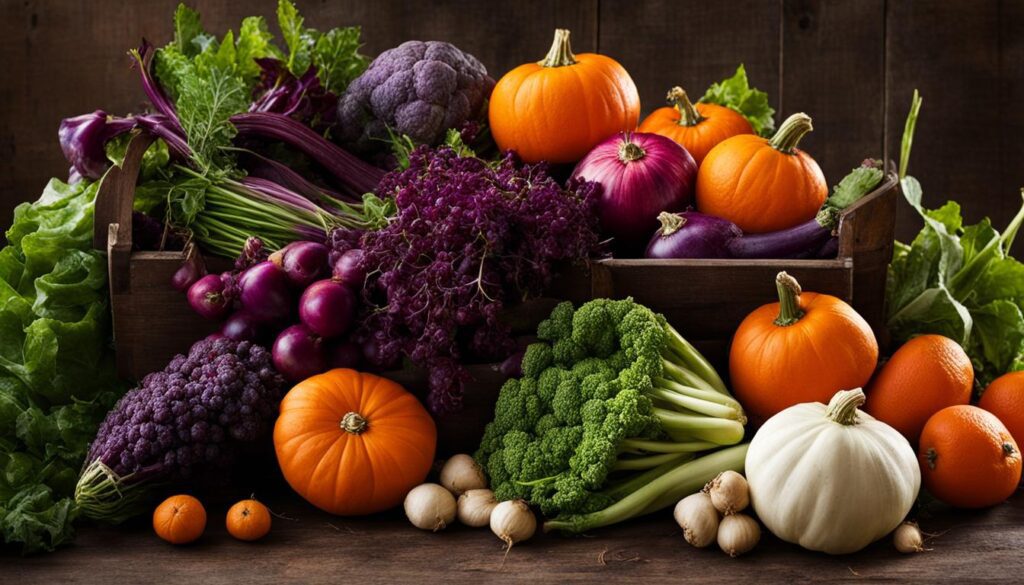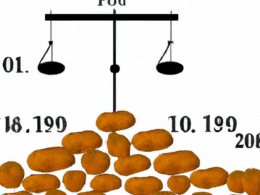As the summer heat subsides, there’s no better time to welcome the season of cooler temperatures and vibrant foliage with an exciting round of fall vegetables. Container gardening presents a fantastic opportunity for both beginners and experienced gardeners to harvest an abundance of fresh homegrown vegetables throughout autumn. Pot gardening enables you to experiment with a diverse range of flavorful crops while enjoying the many benefits of an easy-to-manage and low-maintenance garden.
Key Takeaways
- Fall vegetables flourish in container gardens, providing a bountiful autumn harvest.
- Pot gardening offers a low-maintenance and space-efficient approach to growing your own vegetables.
- Choose from a variety of nutritious and flavorful crops suitable for fall planting, such as beets, garlic, sweet potatoes, lettuce, arugula, carrots, collards, kale, bok choy, spinach, and green onions.
- Containers provide flexibility to extend the growing season and protect your crops from harsh weather conditions.
- Enjoy the unique tastes and unbeatable freshness of homegrown autumn vegetables all season long.
Why Choose Pots for Your Fall Vegetable Garden?
Growing vegetables in pots during the fall season offers numerous benefits that enable you to extend the growing season, making the most of your cool weather crops while saving space and protecting your plants from harsh weather conditions. The following factors make pot gardening an excellent choice for your fall vegetable garden:
Extending the Harvest into the Colder Months
One of the main advantages of container gardening is its ability to help extend the growing season, ensuring you enjoy homegrown produce well past the usual end of the summer season. Cool weather crops like spinach and kale thrive in lower temperatures and often develop a richer, more robust flavor during the fall months. By growing late-season plants in pots, you’ll be able to delight in an abundant harvest despite the drop in outdoor temperatures.
Space Efficiency and Accessibility
Small space gardening, urban gardening, and accessible gardening are all made easier with container gardens. Pots allow for the efficient use of limited space, making it possible to grow various quick-maturing vegetables such as radishes and bush beans. Container garden care is also streamlined, with convenient access to plants and fewer weeds to contend with. These factors make container gardening a particularly suitable choice for those with smaller gardens or those looking to optimize accessibility.
Protecting Your Crops from Harsh Weather
Protecting your crops from the elements is essential for a successful harvest. Pot gardening offers an added level of crop protection, as containers can be easily moved to more sheltered locations during periods of harsh weather. This flexibility is particularly beneficial for growing more delicate, frost-sensitive plants like arugula and mustard greens, which may require additional care to produce a bountiful crop in the cooler months.
Another advantage of container gardening is the ability to cater to the different needs of a variety of plants. Below is a table enumerating several frost-hardy plants and the ideal container sizes for their growth:
| Vegetable | Ideal Container Size |
|---|---|
| Spinach | 6-8 inches deep |
| Kale | 12-18 inches deep |
| Arugula | 6-8 inches deep |
| Mustard Greens | 8-10 inches deep |
| Radishes | 6-8 inches deep |
| Bush Beans | 8-12 inches deep |
By considering the specific needs of each plant and selecting appropriate container sizes, you can provide the best possible environment for your fall vegetables to thrive. Embracing container gardening will not only help you enjoy a satisfying late-season harvest but also contribute to a more sustainable lifestyle, allowing you to savor the benefits of homegrown produce.
Top Leafy Greens to Plant in Pots for Fall
Fall gardening presents a unique opportunity for cultivating flavorful greens that thrive in cooler temperatures. Here, we will discuss some top leafy greens that can be easily grown in pots throughout the fall season.
Growing Spinach for a Nutrient-Rich Harvest
Spinach is a nutrient-rich green known for being one of the healthiest overwinter vegetables. To grow spinach in containers, choose a pot at least 8 inches deep and wide. Plant seeds in late summer or early fall, ensuring your spinach harvest is ready in four to six weeks. Given adequate care, spinach can survive all but the harshest winters in container gardens.
Cultivating Kale for Cold Weather Sweetness
Kale is a sweet green and a cold-hardy plant that is even hardier than other members of the cabbage family. As temperatures drop, kale leaves become sweeter. Plant kale seeds six to eight weeks before the first frost to enjoy a steady supply of this healthful leafy green throughout winter.
Some popular kale varieties for fall gardening include:
- Curly kale
- Lacinato kale (also known as Dinosaur kale)
- Red Russian kale
- Siberian kale
The Benefits of Growing Collard Greens in Containers
Collard greens are another attractive option for fall container gardening. These nutrient-dense and flavorful greens are more palatable during colder months. Plant collard green seeds six to eight weeks before the first average frost for optimum results.
In conclusion, spinach, kale, and collard greens are all excellent choices for fall container gardening. These leafy greens not only provide a bountiful harvest but also deliver an array of health benefits. Embrace the fall gardening season by cultivating these nutrient-rich greens in pots and enjoy their unique flavors throughout the cooler months.
Root Vegetables and Tubers Ideal for Container Farming
Fall container gardening is the perfect opportunity for nurturing root vegetables and tubers like beets and carrots. These cold-hardy crops require little space and can thrive in pots, making them ideal choices for small-scale gardens. Let’s examine tips for successfully cultivating these nutritious winter vegetables in pots.
Harvesting Beets and Their Nutritious Greens
Fall is an excellent time to plant beets in containers as they can withstand cooler temperatures and produce high-quality roots and greens. To ensure their optimal growth, select pots with a minimum depth of 10 to 12 inches. Sow the seeds directly into the potting soil and keep the container in a sunny location to maximize your beet plants’ development.
Once mature, you’ll be able to enjoy not only the sweet and earthy beet roots but also the nutrient-rich leafy tops that resemble spinach in flavor. The greens can be harvested throughout the season, making them an invaluable addition to your container garden.
Enjoying the Sweetness of Homegrown Carrots
Carrots are another root crop that can easily be grown in containers during the fall. Similar to beets, these sweet and crunchy vegetables require pots with sufficient depth to accommodate the long roots they produce. Aim for containers around 12 to 15 inches deep, and choose carrot varieties best suited for your climate and pot size.
Sow the carrot seeds directly into the potting soil and keep the pot in a sunny location to encourage their growth. Carrots will generally take 10 to 12 weeks to sprout, and you can start to harvest them when their tops reach around 1 inch in diameter. As carrots thrive in warmer soil, they will provide you with tender and delectable roots perfect for fall and winter meals.
- Beets: Easy-to-grow, nutritious root vegetables that offer an abundance of sweet roots and tasty greens
- Carrots: Popular root vegetables known for their sweetness and crunchy texture, suitable for growing in deep containers
| Vegetable | Container Depth | Days to Harvest | Benefits |
|---|---|---|---|
| Beets | 10-12 inches | 50-70 days | Nutritious roots and greens, suitable for cool weather |
| Carrots | 12-15 inches | 70-80 days | Sweet roots, ideal for fall and winter consumption |
With beets and carrots in your fall container garden, you’ll be able to enjoy a plentiful harvest of wholesome root vegetables throughout the colder months. By carefully selecting appropriate pots and following growing guidelines, you’ll soon reap the rewards of these flavorful and nutritious winter crops.
Bold Flavors from Potted Fall Vegetables
Adding homegrown garlic and radishes to your autumn gardening efforts will not only extend your harvest in colder months but also infuse your culinary dishes with bold, fresh flavors that store-bought produce simply cannot match. This section will guide you through the process of infusing freshness with homegrown garlic and choosing the perfect pots for pungent radishes and daikon.
Infusing Freshness with Homegrown Garlic
Garlic is a popular ingredient in many recipes, and growing it in your fall container garden will provide you with the most flavorful vegetables imaginable, elevating your dishes to the next level. Planting garlic is simple and requires minimal maintenance, with the added benefit of being able to harvest it at various stages:
- Garlic greens: similar to chives, these tender shoots can be harvested as soon as they grow a few inches tall.
- Fresh garlic bulbs: harvest immature bulbs for a milder flavor and quicker cooking times.
- Mature garlic: Allow bulbs to fully mature for a more robust flavor that will enhance any dish. This typically takes around 6-8 months from planting.
Plant garlic in a deep pot with well-draining soil, and make sure to give it plenty of sunlight to ensure a healthy harvest. The delightful flavor of homegrown garlic will far surpass anything you find at the grocery store.
Picking the Perfect Pots for Pungent Radishes and Daikon
Radishes and daikon radishes are fast-growing, spicy vegetables that are not only delicious but make perfect planting companions for your fall garden. Begin planting radishes and daikon approximately four to six weeks before the first autumn frost to ensure an early winter harvest.
- Select a pot that is at least 6-8 inches deep for radishes and 12-14 inches deep for daikon radishes.
- Fill your pot with well-draining, nutrient-rich soil, and space seeds according to the variety’s guidelines.
- Provide your radishes and daikon with ample sunlight and water consistently, taking care to avoid overwatering.
As these spicy vegetables grow, you can begin to harvest both radishes and daikon as they reach the desired size, typically within 3-5 weeks for radishes and 8-12 weeks for daikon. Not only are they delicious eaten raw in salads or pickled, but they also add a kick to your favorite stir-fry and roasting recipes.
Cruciferous Veggies: A Cold Season Favorite
Among the diverse variety of vegetables that thrive in the fall, cruciferous vegetables stand out as some of the most rewarding and versatile options to include in your container garden. Among these, bok choy is particularly well-suited to cold season gardening, as it flourishes in cooler temperatures and can tolerate partial shade. Bok choy makes an excellent addition to your autumn harvest, providing a fresh and nutrient-dense option for your favorite recipes.
To achieve the best results when planting bok choy in your container garden, sow the seeds from midsummer to early fall. You can expect a reward of harvestable, tender leaves in just about a month. In addition to bok choy, kohlrabi is another cruciferous vegetable worth considering for your fall pot garden. For kohlrabi, you’ll want to plant seeds about six weeks before the first frost in your area to ensure a successful harvest.
With a myriad of flavors and textures available from cruciferous vegetables, you’ll want to choose container-friendly varieties that can withstand the colder weather conditions of autumn. Here are a few options to consider:
| Fall Cruciferous Vegetable | Planting Timeline | Harvest Time |
|---|---|---|
| Bok Choy | Midsummer to Early Fall | About 1 Month |
| Kohlrabi | About 6 Weeks before First Frost | Approximately 60 Days |
| Broccoli (compact varieties) | Early Fall or Late Summer | 60-70 Days |
| Brussels Sprouts (smaller varieties) | Midsummer to Early Fall | 90-100 Days |
By incorporating cruciferous vegetables into your fall container garden, you’re enhancing the diversity and nutritional value of your homegrown harvest. As these vegetables thrive in cooler weather, you’ll be able to extend your gardening season while enjoying the exciting flavors and health benefits they offer.
Can Brussels sprouts be grown in pots in South Carolina for a fall harvest?
Yes, Brussels sprouts can be grown in pots in South Carolina for a fall harvest. The best time for Brussels sprouts planting in South Carolina is around mid-July to mid-August. Make sure the pots are large enough to accommodate the plant’s roots and provide sufficient sunlight for healthy growth.
Conclusion: Embracing the Fall Container Gardening Journey
As the colder months approach, it’s the perfect time to explore the world of fall container gardening. By planting a variety of autumn-harvest vegetables suited for pots, you can maximize your home farming success and enjoy an autumn bounty of delicious produce. Container gardening offers numerous benefits, such as space efficiency and versatility in protecting your crops from harsh conditions, thus extending their growing season and providing you with a continuous supply of tasty vegetables.
From nutrient-rich spinach to the delightful sweetness of homegrown carrots, the possibilities are vast. Fall vegetables like garlicky greens, spicy radishes, and crunchy cruciferous veggies like bok choy all contribute their unique flavors and textures to your pot garden. Remember to consider factors such as pot size, planting timeline, and proper care techniques to ensure a thriving container garden this fall season.
In summary, fall container gardening allows you to savor the benefits of homegrown veggies well into the cooler months, while simultaneously enhancing the visual appeal of your outdoor space. So, don’t hesitate to embark on this rewarding gardening journey and reap the bountiful rewards of your own autumn harvest.












